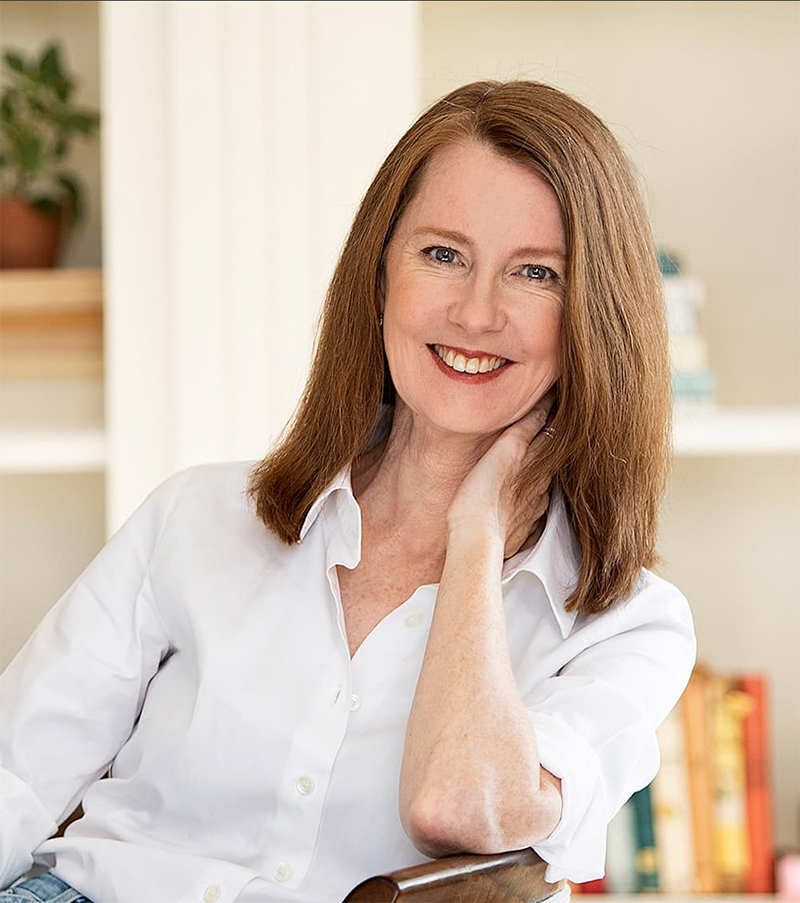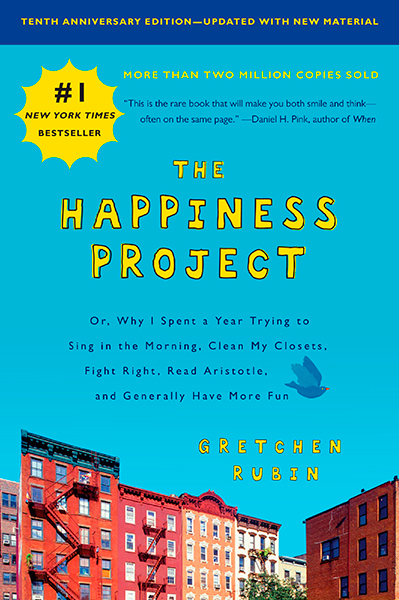
Clerking for US Supreme Court Justice Sandra Day O’Connor gave Kansas City native Gretchen Rubin an insight into happiness: The secret, for O’Connor anyway, was “work worth doing.”
That revelation set Rubin on an unlikely path for a hardworking graduate of Sunset Hill High School, Yale, and Yale Law School. She immersed herself in researching human nature and intellectual development, driven by a central question: Could people change if they wanted to, and how?
Rubin’s studies culminated in The Happiness Project, a humorous and deeply personal account of Rubin taking one year to work hard at having more fun. The book, which came out in 2009, was an instant New York Times bestseller and has sold 3.5 million copies worldwide.
She has since written several more books, launched the Happier with Gretchen Rubin podcast, and built a website, that’s loaded with free resources for increasing happiness, including a personality quiz she developed.
Rubin, who grew up in the Sunset Hill neighborhood, enjoys returning to Kansas City as frequently as possible. She lives on the Upper East Side of New York City with her husband and their daughters, 23 and 17.
In a lively and upbeat telephone call from her home, Rubin talked with IN Kansas City about why seeking happiness is not selfish, seven categories of clutter, and her personal resolution for 2023.
Why do most of us fail at New Year’s resolutions?
I think a big reason is that people set up a resolution in a way that’s not right for them. Like, they see what works really well for somebody else and they think, “Well, if my sister-in-law can get up early and go for a run, then that should work for me.” Or “Everybody tells me I should sign up for a class every week, and I don’t understand why that just rubs me the wrong way and I never want to go.”
I think the key thing is to say, “Well, what kind of person am I? When have I succeeded in the past? Is there something I can learn from things that worked well?” And if something hasn’t worked, maybe think, “Can I achieve the same aim in a different way?”
So, if I think, “I want to spend more time with friends,” but having a standing dinner isn’t working because it’s too much logistics, maybe there’s a different way to connect with friends. Sometimes we think, “I failed, there’s something wrong with me,” instead of saying, “that didn’t work, let me try it a different way.”
What do you say to people who believe that happiness is a frivolous or selfish pursuit?
That is a big concern. People think, yeah, that happy people are complacent or just thinking about their own pleasure all the time. But, in fact, research shows that happier people are more interested in the problems of people around them, and they are more interested in the problems of the world. [Happy people] vote more, they volunteer more, they’re more likely to help out if a family member or a friend or a colleague needs a hand.
When people are unhappy they can become defensive and isolated, and they’re preoccupied with their own problems. When we are happier it gives us the emotional wherewithal to turn outward.
In The Happiness Project, you identify seven types of clutter, which in addition to being hilarious, is useful, because understanding why we are hanging onto this thing we don’t need seems like a key precondition to being able to toss it. Will you please give us an example from your own life of each type of clutter, which I’ll list:
First: nostalgic clutter, or relics from your earlier life.
My grandmother’s china set and the tennis racket I used in high school.
Conservation clutter, things that are useful, but you don’t actually use them.
Glass jars.
Bargain clutter, things you don’t use that you got for a good price.
A giant fish platter.
Freebie clutter.
Conference swag and tote bags.
Crutch clutter, things you use but you know you shouldn’t.
My horrible sweatshirt that I love, but it is ratty, and I need to move on to a better one.
Aspirational clutter, things you don’t use but you would like to be the kind of person who does.
Linen cocktail napkins and a yoga mat.
Buyer’s remorse clutter, things you spent too much on, so you need to keep them until you get use out of them.
A pair of expensive shoes that just don’t fit.
In The Happiness Project you explain a paradox: People think if they clean out their closets and get rid of stuff they don’t wear, they will feel like they don’t have enough, but the opposite is true. When everything in there is stuff you use, it feels like more than before.
Yes! It’s the most surprising thing, and I hear people say that over and over. People say, “I have so much more to wear now.”
Because the stuff you like is not buried by stuff you don’t wear.
Right! It’s a universal experience.

In your book you frequently reference what you call your gold-star tendency, that is, feeling driven to excel and to be rewarded. What is your best advice for people with that disposition?
Wanting approval from others within limits can be positive. But it can make you very needy and demanding. We need to have the self-awareness to know just how much that need for approval is driving our behavior. I would do things in order to get a gold star, and then if I didn’t get the gold star, I would feel incredibly resentful. So instead, I started telling myself, “I’m doing this for me.”
Can you give an example?
Sure. Instead of cleaning the kitchen, thinking, “My husband will be so pleased with this,” which sets up me getting really angry if he doesn’t notice, I’ll say, “I would really love to see everything in this kitchen cleaned up and put away, so I’m doing this to suit myself.” That sounds more selfish, but it really means I’m not expecting him to give me a standing ovation. I’m not being needy.
And it puts you in charge of your own happiness.
Absolutely. Yes, yes, yes, yes.
Your younger sister, Elizabeth Craft, who co-hosts your “Happier” podcast, has noted the irony of your “dogged, systematic” approach to increasing happiness. Have you found that Type A and Type B personalities need different strategies to become happier?
One hundred percent. I don’t use Type A and Type B—I have what I call the Four Tendencies: Upholders, Questioners, Obligers, and Rebels. It’s very easy to assume that “What’s true for me is true for everyone,” and “If something works for me, it should work for other people,” and “If something doesn’t work for me, it shouldn’t work for other people.” This is a huge mistake, because it means we’re constantly steering each other in the wrong direction.
For example, I’m a morning person, and I used to think everybody’s at their freshest and finds their highest focus in the morning, and that’s just not true. Thirty percent of people are night people.
Even little things—like, I’m a desk person. Every room in our house except the bath has a desk. But neither of my daughters uses desks. They don’t sit at a desk and work. I used to badger them, “Go sit at your desk!” I need to sit at a desk, but they don’t. So why am I nagging them about it? Who cares?
The number one resolution people say makes them happier is to make their bed every morning, but there are some people that are like, “There’s no way I’m making my bed when I get up. That’s a dumb use of time. I make it every night.” Fine. We’re all different.
When you were designing the Happier app, how did you address the tension between people that want an app to optimize every aspect of their lives and studies that show people who spend less time with devices tend to be happier?
Technology can be amazing and freeing and creative and terrific, and it can also really bring us down. I think it depends what people are using devices for. Using the Happier app is not a big time suck. It’s not like YouTube or CandyCrush where people can spend a lot of time on it. You get it, you do it, and you get out. It’s efficient. That said, some people prefer a paper journal because they find that more satisfying.
But yeah, like, there’s an app that randomly chimes throughout the day to remind you to be mindful, and nothing would make me feel less calm and mindful than my phone randomly beeping at odd times. So, you always want to be thinking, “Is this tool working for me or not working for me?”
As a native Kansas Citian and longtime New York resident, have you observed differences in the relative happiness of New Yorkers and Kansas Citians?
I think it’s so much more individual than it is city by city.
“Kansas City is the most livable city. Anything you want to do, there’s just not that much hassle. And it is so beautiful.”
What are some things about New York that you can tap into that increase your happiness and then the same for Kansas City?
I’ve thought about that a lot. One thing I love in New York that I can’t get as much of in Kansas City is public transportation. I do not like to drive, and I love the fact that I do not have to drive.
I love the density of [New York]—you can walk five blocks and you’re in a completely different sort of biome. There’s so much to see, and I like that kind of intensity, which is exactly what some people do not like about New York.
Kansas City is the most livable city. Anything you want to do, there’s just not that much hassle. And it is so beautiful. I think of Loose Park or walking through the Plaza, walking on the grounds of the Nelson-Atkins and the big, heavy architecture of the houses, which I really like. It’s just a pleasant place to be. And there’s Winstead’s!
Then there’s the barbecue situation. My husband would argue that there’s good barbecue in New York City. . .
Nah.
There certainly isn’t the outstanding barbecue that Kansas Citians demand.
What’s one small change you would like to make in your life in 2023 that you think will make you happier?
I want to make sure that I spend quality time outside each day. A couple of years ago I started going to the Metropolitan Museum every day, which has been this amazing thing, but that meant I spent less time in Central Park. Now I’m like, I really love the Met, but I need to up my game in terms of being out in nature.
Interview condensed and minimally edited for clarity.


